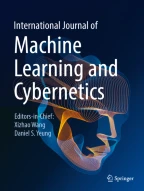Abstract
Although TWSVM always achieves good performance for data classification, it does not take full advantage of the statistical information of the training data. Recently proposed twin mahalanobis distance-based support vector machine (TMSVM) modifies the standard TWSVM by constructing a pair of Mahalanobis distance-based kernels according to the covariance matrices of two classes of training data, which improves the generalization ability. However, TMSVW solves two dual quadratic programming problems. Moreover, it is proposed to deal with binary classification problems, while most of pattern recognition problems are problems of multi-class classification. In order to enhance the performance of TMSVM, in this paper, we formulate a fast least squares version of TMSVM which solves two modified primal problems instead of two dual problems. The solution of two modified primal problems can easily be obtained by solving a set of linear equations in the primal space. Then we propose a new multiclass classification algorithm, named DAG-LSTMSVM for multi-class classification, by combining least squares TMSVM and directed acyclic graph (DAG). A mahalanobis distance-based distance measure is designed as the class separability criterion to construct the optimal DAG structure. A modified shuffled frog leaping algorithm-based model selection for DAG-LSTMSVM is suggested for parameter selection. The experimental results on artificial dataset and UCI datasets show that the proposed algorithm obtains high classification accuracy and good generalization ability.
Similar content being viewed by others
Explore related subjects
Discover the latest articles, news and stories from top researchers in related subjects.References
Cortes C, Vapnik VN (1995) Support vector networks. Mach Learn 20(2):273–297
Vapnik VN (1998) The nature of statistical learning theory. Springer, New York
Wang XZ, He Q, Chen DG et al (2005) A genetic algorithm for solving the inverse problem of support vector machines. Neurocomputing 68:225–238
Suykens J, Vandewalle J (1999) Least square support vector machine classifiers. Neural Process Lett 9(3):293–300
G Fung, Mangasarian OL (2001) Proximal support vector machine classifiers[C]. In: Proc. 7th ACMSIFKDD intl. conf. on knowledge discovery and data mining, ACM Press, New York, pp 77–86
Mangasarian OL, Wild E (2006) Multisurface proximal support vector machine classification via generalized eigenvalues. IEEE Trans Pattern Anal Mach Intell 28(1):69–74
Jayadeva R, Khemchandni S (2007) Chandra. Twin support vector machines for pattern classification. IEEE Trans Pattern Anal Mach Intell 29(5):905–910
Ding SF, Yu JZ, Qi BJ et al (2014) An overview on twin support vector machines. Artif Intell Rev 42(2):245–252
Kumar MA, Gopal M (2009) Least squares twin support vector machines for pattern classification. Expert Syst Appl 36(4):7535–7543
Wang YN, Zhao X, Tian YJ (2013) Local and global regularized twin SVM. Proced Comput Sci 18:1710–1719
Tanveer M (2015) Robust and sparse linear programming twin support vector machines. Cogn Comput 7(1):137–149
Shao YH, Chen WJ, Zhang JJ et al (2014) An efficient weighted Lagrangian twin support vector machine for imbalanced data classification. Pattern Recogn 47(9):3158–3167
Kumar MA, Gopal M (2008) Application of smoothing technique on twin support vector machines. Pattern Recogn Lett 29(13):1842–1848
Ding SF, Huang HJ, Weighted ZZS (2013) Smooth CHKS twin support vector machines. J Softw 24(11):2548–2557
Xie XJ, Sun SL (2015) Multitask centroid twin support vector machines. Neurocomputing 149(2):1085–1091
Ding SF, Wu FL, Shi ZZ (2014) Wavelet twin support vector machine. Neural Comput Appl 25(6):1241–1247
Ding SF, Huang HJ, Xu XZ et al (2014) Polynomial Smooth Twin Support Vector Machines. Appl Math Inf Sci 8(4):2063–2071
Peng XJ, Xu D (2012) Twin Mahalanobis distance-based support vector machines for pattern recognition. Inf Sci 200:22–37
Wang XZ, Lu SX, Zhai JH (2008) Fast fuzzy multi-category SVM based on support vector domain description. Int J Pattern Recogn Artif Intell 22(1):109–120
Chu M, Wang A, Gong R et al (2014) Multi-class classification methods of enhanced LS-TWSVM for strip steel surface defects. J Iron Steel Res Int 21(2):174–180
Xu Y, Guo R (2014) A twin hyper-sphere multi-class classification support vector machine. J Intell Fuzzy Syst 27(4):1783–1790
Yang ZX, Shao YH, Zhang XS (2013) Multiple birth support vector machine for multi-class classification. Neural Comput Appl 22(1):153–161
Tomar D, Agarwal S (2015) A comparison on multi-class classification methods based on least squares twin support vector machine. Knowl-Based Syst 81:131–147
Xu YT, Guo R, Wang LS (2013) A twin multi-class classification support vector machine. Cogn Comput 5(4):580–588
Xie J, Hone K, Xie W et al (2013) Extending twin support vector machine classifier for multi-category classification problems. Intell Data Anal 17(4):649–664
Shao YH, Chen WJ, Huang WB et al (2013) The best separating decision tree twin support vector machine for multi-class classification. Proced Comput Sci 17:1032–1038
Elbeltagi E, Hegazy T, Grierson D (2005) Comparison among five evolutionary-based optimization algorithms. Adv Eng Inform 19(1):43–53
Wang XB (2014) Applied Multivariate Analysis. Shanghai University of Finance and Economics Press, Shanghai
Wu FL, Ding SF, Huang HJ, Zhu ZB (2014) Mixed kernel twin support vector machines based on the shuffled frog leaping algorithm. J Comput 9(4):947–955
Lin J, Zhong YW (2013) Accelerated shuffled frog-leaping algorithm with Gaussian mutation. Inf Technol J 12(23):7391–7395
Acknowledgments
This work is supported by the National Natural Science Foundation of China (No. 61379101), and the National Key Basic Research Program of China (No. 2013CB329502).
Author information
Authors and Affiliations
Corresponding author
Rights and permissions
About this article
Cite this article
Zhang, X., Ding, S. & Sun, T. Multi-class LSTMSVM based on optimal directed acyclic graph and shuffled frog leaping algorithm. Int. J. Mach. Learn. & Cyber. 7, 241–251 (2016). https://doi.org/10.1007/s13042-015-0435-5
Received:
Accepted:
Published:
Issue Date:
DOI: https://doi.org/10.1007/s13042-015-0435-5
